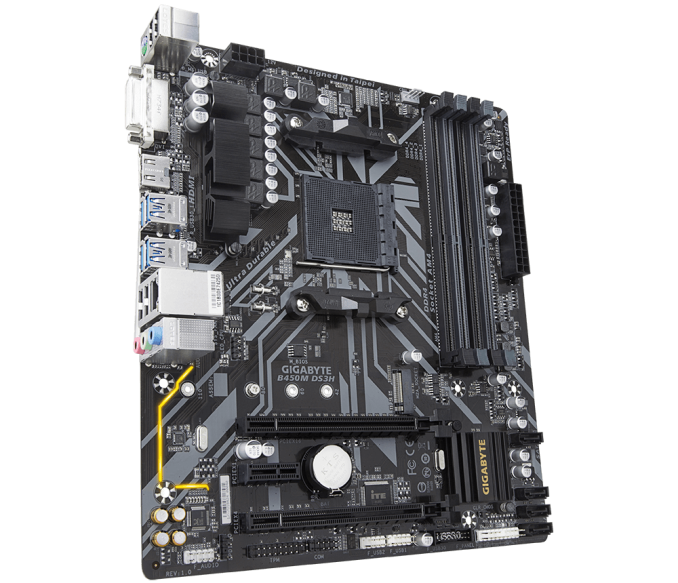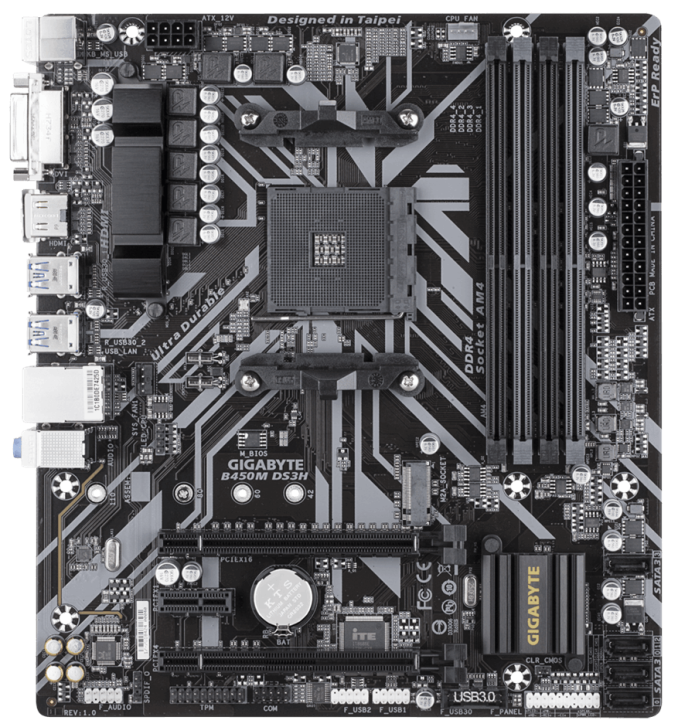Analyzing B450 for AMD Ryzen: A Quick Look at 25+ Motherboards
by Gavin Bonshor on July 31, 2018 8:00 AM ESTGIGABYTE B450M DS3H
The last of GIGABYTE’s launch day motherboards comes via the B450M DS3H which hails from the Ultra Durable range. With the shift here from gaming to a more subtle theme, the styling choices opted here by GIGABYTE come across as less ‘in your face’ without RGB LEDs built into the heatsinks, but users looking to make use of rainbow-colored RGB can do so through a single RGB LED strip header.
Without a lot of the bells and whistles of the B450 Aorus motherboards, what the B450M DS3H does focus on is providing value without sacrificing too much on the overall quality. The general controller choice does put this board in the lower range of AM4 boards available, but the Realtek ALC887 audio codec still does a decent job of providing onboard audio. With a Realtek GbE LAN controller present also, the DS3H is admirable for users on a strict budget, but who also require a smaller microATX form factor.
The main bulk of the board's aesthetic prowess come from the PCB, which features a black base with a grey striped circuit-like pattern emanating from the corners of the board towards the socket. This entry-level offering has two full-length PCIe slots; the top slot is PCIe 3.0 x16 while the bottom slot is PCIe 2.0 x4. Sitting in between the two full-length slots is a single PCIe 2.0 x1 slot. Thanks to the two full-length slots, this means AMD CrossFire multi-graphics card configurations are supported, although it should be noted NVIDIA SLI is not supported across the B450 chipset; this is due to a limitation of PCI bandwidth.
Like all of GIGABYTE’s launch day range of B450 motherboards, the B450M DS3H has four memory slots capable of supporting DDR4-3200 memory. This means that a total of 64 GB of system memory can be installed with both ECC and non-ECC Un-buffered memory types being supported. There is also support for DDR4 memory with XMP profiles built-in.
Storage wise, the main bulk is made of from four SATA ports. These ports all feature straight angled slots, which is a pure cost-cutting measure and a consequence of the board's entry-level pedigree. The SATA ports also support RAID 0, 1 and 10 arrays. Also present is a single PCIe 3.0 x4/SATA M.2 slot with support for up to M.2 22110 (22 x 110 mm) SSDs.
In terms of power delivery, the B450M DS3H looks to sport a seemingly simple, but ample, 4+3 hybrid digital design, with a very small and lightweight looking heatsink across the CPU section of the VRM; this leaves the SoC area at the mercy of the system's passive cooling capabilities. Not so much an issue when using a discrete graphics card but could cause potential heat issues if a user intends to use one of the Ryzen 2000 series APUs and overclock them for better performance.
The rear panel on the B450M DS3H microATX motherboard consists of a fairly basic selection of ports and connections including four USB 3.1 5 Gbps ports and four additional USB 2.0 Type-A ports. Also included is a PS/2 combo port, as well as a single LAN port controlled by a Realtek GbE networking chip. The three 3.5mm audio jacks making up the onboard audio are powered by the Realtek ALC887 audio codec. Finishing off the rear panel is a pairing of video outputs which consist of a DVI-D, and HDMI 2.0 port which makes this board suitable for a low-end and entry-level gaming system when paired up with an APU.
The crux of the GIGABYTE B450M DS3H comes in the way of value ($69.99), but without sacrificing core features which are used frequently on most home systems. From the Realtek ALC887 which is a more budget-friendly audio codec opposed to say the ALC1220, to the use a cheaper Realtek GbE networking chip opposed to say the Intel I211-AT featured on their own B450 Aorus Pro/Aorus Pro WIFI models; it gives the B450M DS3H more function and value over style, over the top aesthetics and unnessacary cost spiking componentry.





_thumb.png)
_thumb.png)
_thumb.png)
_thumb.png)
_thumb.png)
_thumb.png)








62 Comments
View All Comments
bi0logic - Tuesday, July 31, 2018 - link
It looks like the price link to the "TUF B450-Plus Gaming" is going to an amazon search for "ASRock B450M Pro4"eastcoast_pete - Tuesday, July 31, 2018 - link
Thanks Gavin, I know this is a lot of information to go through and present. I would love to see a follow-up on these questions:1. Especially for these compact boards, any problems with stock processor heat sinks blocking DIMM slots, i.e. do DIMMs with heat spreaders still fit with a Wraith or Spire cooler, respectively?
2. I have my eye on the Aorus Pro WiFi or something similar, but am wary of the placement of the WiFi antenna connectors right next to two of the USB 3 connectors. I frequently use 3-4 USB 3 devices at the same time frequently, and am wary of the USB 3 - WiFi interference with that placement. Any chance Gigabyte could state if/that they got that taken care of?
Thanks!
Also, still looking forward to your Ryzen 2200/2400 GPU overclock chapter on that duo. Any chance we'll see it soon?
sonofgodfrey - Tuesday, July 31, 2018 - link
Second to last table is labeled X470 Motherboards.PingSpike - Tuesday, July 31, 2018 - link
It looks like the ASUS ROG STRIX B450-F GAMING inherits some of the layout features of the (much more expensive) x470 Crosshair 7 in that it steals some of the CPU lanes to get a second full PCI-e 3.0 M.2 slot. Then 8x goes to PCI-e 16 1, the remaining 4x to PCI-e 16 2 and finally a chipset PCI-e 2.0On the surface, this seems like it has totally ignored the bifrucation limitations that supposedly are inherent to the B450 chipset.
In other words, I thought you couldn't get that on this chipset.
Dragonstongue - Tuesday, July 31, 2018 - link
well at least the pricing is "more inline" with the pricing they should be, newer boards, better componentes that actually save the maker a bit of coin per board made, so they keep the same "launch price" is acceptable in my books coming from gen 1 (I so hate the naming AMD used for Ryzen 1xxx and 2xxx needless confusion for nothing)x3xx to x4xx same concept, reduced price to produce so they save some money, but the vast majority of vendors used these "savings" to cram more disco light show RGB on the boards to jack the price up some instead.
seems at least with the B4xx boards the vendors took a "better" approach beyond a few more "premium" boards which rightfully have an increased price (justifiable, maybe, but I myself have zero need of RGB and would only buy a more expensive board that offered them at the increased price if they were WORTH it as far as just overall better then lower cost boards, sadly, there seems to be little difference in more "premium" beyond a butt load of extra RGB little better in VRM etc which are much more useful and required IMO)
they could almost have a market for the premium boards RGB free, so pay a bit less for people like me who do not want all the RGB crud but still get the increased premium sound/VRM/BIOS etc ^.^
WasHopingForAnHonestReview - Wednesday, August 1, 2018 - link
Nice review. Good work.Im amazed that almost every comment is a nitpick. Rough life, Ian.
Flappergast - Wednesday, August 1, 2018 - link
Nice overview on the last page. I’m looking for mITX WiFi - nice to see some good boardsSakkura - Wednesday, August 1, 2018 - link
As documented by Buildzoid, the Asrock B450 Pro4 does not have the claimed 6+3-phase VRM. It is a pure 3+3-phase. Same probably applies for the B450M Pro4.https://youtu.be/yWAwOH-egFs?t=2104
JohanPirlouit - Wednesday, August 1, 2018 - link
Hi everyone,Am I the only one to see that on the AMD picture:
- CPU: 2x SATA 3Gbps
- Chipset: 6x SATA 3Gbps
What do AMD talks about: SATA "3" (known as "6Gbps") or SATA 3Gbps (aka SATA II)?
Sakkura - Wednesday, August 1, 2018 - link
They mean SATA3 = SATA 6Gbps. Annoying that we keep running into these easily confused naming schemes (see also: USB 3.1 Gen1 and Gen2). At least SATA is getting old enough that we should soon be able to just drop the version number (unlike USB 2.0 there's really no reason to make modern hardware with SATA2).